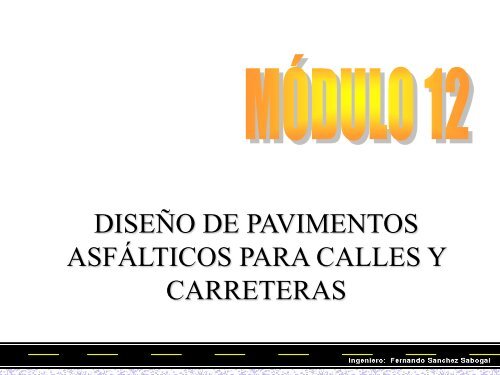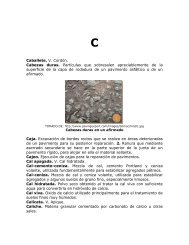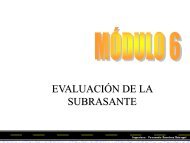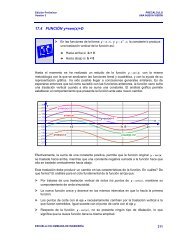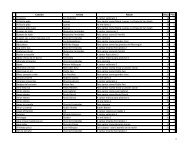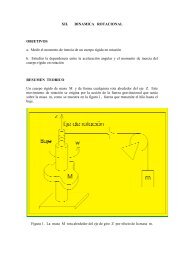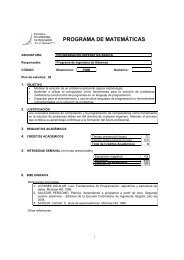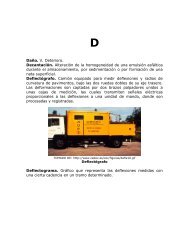Diseños de pavimentos asfálticos para calles y carreteras - Escuela ...
Diseños de pavimentos asfálticos para calles y carreteras - Escuela ...
Diseños de pavimentos asfálticos para calles y carreteras - Escuela ...
Create successful ePaper yourself
Turn your PDF publications into a flip-book with our unique Google optimized e-Paper software.
DISEÑO DE PAVIMENTOS<br />
ASFÁLTICOS PARA CALLES Y<br />
CARRETERAS
Introducción<br />
Métodos empíricos <strong>de</strong> diseño<br />
Método AASHTO - 93<br />
Mo<strong>de</strong>los INVÍAS - 98<br />
Métodos empírico-mecanísticos <strong>de</strong> diseño<br />
Método SHELL – 98 (SPDM 3.0)<br />
CONTENIDO<br />
Diseño <strong>de</strong> <strong>pavimentos</strong> sobre suelos blandos
DISEÑO DE PAVIMENTOS ASFÁLTICOS<br />
PARA CALLES Y CARRETERAS<br />
INTRODUCCIÓN
Generalida<strong>de</strong>s<br />
INTRODUCCIÓN<br />
La mayoría <strong>de</strong> los métodos <strong>de</strong> diseño <strong>de</strong><br />
<strong>pavimentos</strong> tienen un alto grado <strong>de</strong> empirismo,<br />
propio <strong>de</strong> las agencias que los han <strong>de</strong>sarrollado<br />
Es corriente obtener diferentes espesores al<br />
aplicar distintos métodos <strong>de</strong> diseño, empleando<br />
los mismos datos <strong>de</strong> entrada
Generalida<strong>de</strong>s (cont.)<br />
Gran parte <strong>de</strong> estas diferencias se <strong>de</strong>be a la falta <strong>de</strong><br />
una <strong>de</strong>scripción precisa y cuantitativa <strong>de</strong> lo que<br />
constituye la falla <strong>de</strong> un pavimento <strong>de</strong> calle o<br />
carretera, así como a los niveles <strong>de</strong> confiabilidad que<br />
consi<strong>de</strong>ran los diferentes métodos<br />
Los procesos <strong>de</strong> diseño <strong>de</strong> <strong>pavimentos</strong> se pue<strong>de</strong>n<br />
dividir en dos grupos:<br />
— Empíricos<br />
—Empírico - mecanísticos<br />
INTRODUCCIÓN
INTRODUCCIÓN<br />
PROCESOS EMPÍRICOS DE DISEÑO<br />
Se basan en los resultados <strong>de</strong> experimentos o en la<br />
experiencia<br />
Requieren un elevado número <strong>de</strong> observaciones <strong>para</strong><br />
establecer relaciones aceptables entre las variables y los<br />
resultados <strong>de</strong> las pruebas<br />
No es necesario establecer una base científica firme<br />
<strong>de</strong> las relaciones, en la medida en que se reconocen sus<br />
limitaciones
INTRODUCCIÓN<br />
PROCESOS EMPÍRICOS DE DISEÑO<br />
En muchos casos resulta más conveniente confiar en<br />
la experiencia que tratar <strong>de</strong> cuantificar la causa exacta<br />
y el efecto <strong>de</strong> ciertos fenómenos<br />
Ejemplos <strong>de</strong> métodos <strong>de</strong> diseño <strong>de</strong> concepción<br />
empírica son el <strong>de</strong> California (Hveem y Carmany), el<br />
AASHTO-93 y el INVIAS-98
INTRODUCCIÓN<br />
PROCESOS EMPÍRICO - MECANÍSTICOS DE DISEÑO<br />
Incorporan elementos <strong>de</strong> ambos planteamientos<br />
La componente mecánica <strong>de</strong>termina las reacciones<br />
<strong>de</strong>l pavimento, tales como esfuerzos, <strong>de</strong>formaciones y<br />
<strong>de</strong>flexiones, mediante el uso <strong>de</strong> mo<strong>de</strong>los matemáticos<br />
La porción empírica relaciona estas reacciones con<br />
el comportamiento <strong>de</strong> la estructura <strong>de</strong>l pavimento (por<br />
ejemplo, relaciona una <strong>de</strong>flexión calculada<br />
matemáticamente, con la vida real <strong>de</strong>l pavimento)
INTRODUCCIÓN<br />
PROCESOS EMPÍRICO - MECANÍSTICOS DE DISEÑO<br />
Aunque existen técnicas mecanísticas complejas <strong>de</strong><br />
cálculo, los mo<strong>de</strong>los elásticos lineales sujetos a carga<br />
estática son los más empleados en la solución <strong>de</strong><br />
problemas rutinarios <strong>de</strong> ingeniería <strong>de</strong> <strong>pavimentos</strong><br />
Ejemplos <strong>de</strong> métodos <strong>de</strong> diseño <strong>de</strong> <strong>pavimentos</strong> que<br />
usan estos procesos son el <strong>de</strong>l Instituto <strong>de</strong>l Asfalto, el<br />
<strong>de</strong> Shell y el AASHTO 2002
DISEÑO DE PAVIMENTOS ASFÁLTICOS<br />
MÉTODOS EMPÍRICOS<br />
DE DISEÑO
MÉTODOS EMPÍRICOS DE DISEÑO<br />
MÉTODO AASHTO - 93
MÉTODO AASHTO - 93<br />
FUNDAMENTOS DEL MÉTODO<br />
Se basa en los resultados AASHO Road Test<br />
En la revisión realizada en 1986 se introdujeron<br />
factores <strong>de</strong> confiabilidad, drenaje y aspectos climáticos<br />
Su criterio <strong>de</strong> falla es el índice <strong>de</strong> servicio final (p t)
MÉTODO AASHTO - 93<br />
FUNDAMENTOS DEL MÉTODO<br />
El tránsito que lleva a la falla <strong>de</strong>l pavimento es<br />
función <strong>de</strong>l número estructural, <strong>de</strong> la resistencia <strong>de</strong> la<br />
subrasante, <strong>de</strong> la pérdida <strong>de</strong>seada <strong>de</strong> índice <strong>de</strong><br />
servicio y <strong>de</strong> la confiabilidad elegida<br />
Incluye la posibilidad <strong>de</strong> que se reduzca el periodo<br />
<strong>de</strong> diseño por la presencia <strong>de</strong> suelos <strong>de</strong> subrasante<br />
expansivos
Serviciabilidad<br />
DEFINICIONES<br />
MÉTODO AASHTO - 93<br />
Capacidad <strong>de</strong> un pavimento <strong>de</strong> servir al tránsito que hace<br />
uso <strong>de</strong> él en un instante <strong>de</strong>terminado, <strong>de</strong>s<strong>de</strong> el punto <strong>de</strong><br />
vista <strong>de</strong>l usuario<br />
Comportamiento <strong>de</strong>l pavimento (performance)<br />
Ten<strong>de</strong>ncia <strong>de</strong> la serviciabilidad con el incremento en el<br />
número <strong>de</strong> aplicaciones <strong>de</strong> carga por eje<br />
Periodo <strong>de</strong> comportamiento (periodo <strong>de</strong> diseño)<br />
Lapso que transcurre <strong>de</strong>s<strong>de</strong> que un pavimento es construido<br />
o rehabilitado, hasta que alcanza su serviciabilidad terminal
MÉTODO AASHTO - 93<br />
CONSIDERACIONES DE DISEÑO<br />
Concepto <strong>de</strong> serviciabilidad – comportamiento<br />
La serviciabilidad <strong>de</strong> un pavimento se expresa en<br />
términos <strong>de</strong> su Índice <strong>de</strong> Servicio Presente (ISP)
MÉTODO AASHTO - 93<br />
CONSIDERACIONES DE DISEÑO<br />
Concepto <strong>de</strong> serviciabilidad – comportamiento<br />
Fórmula <strong>de</strong>l Índice <strong>de</strong> Servicio Presente (ISP) <strong>para</strong><br />
<strong>pavimentos</strong> <strong>asfálticos</strong><br />
sv = Varianza <strong>de</strong> la pendiente <strong>de</strong>l perfil longitudinal<br />
(c + p) = Área con grietas clases 2 y 3 más área parchada<br />
por cada 1000 pies 2<br />
RD = Ahuellamiento medido con una regla <strong>de</strong> 1.20 metros
LogW<br />
Ecuación <strong>de</strong> comportamiento<br />
18<br />
MÉTODO AASHTO - 93<br />
CONSIDERACIONES DE DISEÑO<br />
ISP<br />
<br />
log<br />
4.<br />
2 1.<br />
5<br />
( )( ) ( 9.<br />
36)(log(<br />
1))<br />
0.<br />
20<br />
<br />
z So SN <br />
<br />
( 2.<br />
32)(log<br />
M ) <br />
R<br />
R<br />
1094<br />
0.<br />
4 <br />
5.<br />
19<br />
( SN 1)<br />
8.<br />
07
CONSIDERACIONES DE DISEÑO<br />
Significado <strong>de</strong> los términos <strong>de</strong> la ecuación<br />
W 18 = número <strong>de</strong> aplicaciones <strong>de</strong> ejes simples equivalentes <strong>de</strong> 18 kip<br />
(80 kN) hasta el tiempo t en el cual se alcanza ISP = p t<br />
SN = número estructural<br />
ISP = p i - p t = diferencia entre los índices <strong>de</strong> servicio inicial y terminal<br />
M R = módulo resiliente <strong>de</strong> la subrasante ( libras/pg 2 )<br />
MÉTODO AASHTO - 93<br />
So = <strong>de</strong>sviación estándar total <strong>de</strong> la distribución normal <strong>de</strong> los errores<br />
asociados con las predicciones <strong>de</strong> tránsito y <strong>de</strong> comportamiento<br />
<strong>de</strong>l pavimento (0.44-0.49)<br />
z R = parámetro estadístico asociado con distribuciones normales <strong>de</strong><br />
datos, que consi<strong>de</strong>ra la probabilidad <strong>de</strong> que el índice <strong>de</strong> servicio<br />
<strong>de</strong>l pavimento sea superior a p t durante el periodo <strong>de</strong> diseño
MÉTODO AASHTO - 93<br />
REPRESENTACIÓN GRÁFICA DE LA ECUACIÓN
MÉTODO AASHTO - 93<br />
CONSIDERACIONES DE DISEÑO<br />
NIVELES DE CONFIABILIDAD RECOMENDADOS POR AASHTO<br />
Clasificación funcional <strong>de</strong> Nivel recomendado <strong>de</strong> confiabilidad (%)<br />
la vía<br />
Urbana Rural<br />
Autopistas 85 - 99.9 80 - 99.9<br />
Arterias principales 80 - 99 75 - 95<br />
Colectoras 80 - 95 75 - 95<br />
Locales 50 - 80 50 - 80
MÉTODO AASHTO - 93<br />
CONSIDERACIONES DE DISEÑO<br />
RELACIONES ENTRE CONFIABILIDAD Y Z R EN UNA DISTRIBUCIÓN NORMAL<br />
Confiabilidad (%) 50 75 80 85 95 99 99.9<br />
zR 0 0.674 0.842 1.037 1.645 2.327 3.08
Módulo resiliente efectivo (M R)<br />
MÉTODO AASHTO - 93<br />
CONSIDERACIONES DE DISEÑO<br />
Es el módulo resiliente promedio que se traduce en un<br />
daño <strong>de</strong>l pavimento (U f) igual al que se alcanzaría si se<br />
usaran valores modulares estacionales:<br />
—Se divi<strong>de</strong> el año en periodos con diferente M R con<br />
base en la humedad <strong>de</strong>l suelo o en la variación <strong>de</strong> las<br />
<strong>de</strong>flexiones medidas en <strong>pavimentos</strong> construidos sobre<br />
el mismo suelo
Módulo resiliente efectivo (M R)<br />
—Se <strong>de</strong>termina el daño relativo por periodo<br />
U f = 1.8 x 10 6 * M R -2.32<br />
—Se calcula el daño relativo promedio<br />
MÉTODO AASHTO - 93<br />
CONSIDERACIONES DE DISEÑO<br />
—Se halla el módulo resiliente efectivo a partir <strong>de</strong>l<br />
daño relativo promedio, usando la misma<br />
ecuación
MÉTODO AASHTO - 93<br />
CONSIDERACIONES DE DISEÑO<br />
VARIACIÓN DEL MÓDULO DURANTE EL AÑO
MÉTODO AASHTO - 93<br />
CONSIDERACIONES DE DISEÑO<br />
VARIACIÓN DEL MÓDULO DURANTE EL AÑO
MÉTODO AASHTO - 93<br />
AJUSTE DEL M R DE LA SUBRASANTE POR LAS VARIACIONES<br />
ESTACIONALES
CONSIDERACIONES DE DISEÑO<br />
Número estructural (SN)<br />
La resistencia <strong>de</strong>l pavimento se representa por SN, el cual es<br />
función <strong>de</strong>l espesor <strong>de</strong> las capas, <strong>de</strong> los coeficientes<br />
estructurales <strong>de</strong> ellas y <strong>de</strong>l coeficiente <strong>de</strong> drenaje<br />
El número estructural total <strong>de</strong>l pavimento está dado por :<br />
SN = Sa i*D i*m i<br />
MÉTODO AASHTO - 93
CONSIDERACIONES DE DISEÑO<br />
Número estructural (SN)<br />
SN = a 1*D 1+ a 2*D 2*m 2+ a 3*D 3*m 3<br />
MÉTODO AASHTO - 93<br />
D 1,2,3 = espesores <strong>de</strong> capas asfálticas, base y subbase<br />
respectivamente (pulgadas)<br />
a i = coeficiente estructural <strong>de</strong> capa i, <strong>de</strong>pendiente <strong>de</strong> su módulo<br />
m i = coeficientes <strong>de</strong> drenaje <strong>para</strong> capas no estabilizadas,<br />
<strong>de</strong>pendiente <strong>de</strong>l tiempo requerido <strong>para</strong> drenar y <strong>de</strong>l tiempo en<br />
que la humedad se encuentre en niveles cercanos a la saturación
CONSIDERACIONES DE DISEÑO<br />
Coeficientes estructurales <strong>de</strong> capa (a i)<br />
Mi<strong>de</strong>n la capacidad relativa <strong>de</strong> una unidad <strong>de</strong><br />
espesor <strong>de</strong> una <strong>de</strong>terminada capa <strong>para</strong> funcionar como<br />
componente estructural <strong>de</strong>l pavimento<br />
Los coeficientes estructurales <strong>de</strong>pen<strong>de</strong>n <strong>de</strong>:<br />
—Resistencia <strong>de</strong>l material (CBR, módulo, etc)<br />
—Calidad <strong>de</strong> la construcción<br />
—Estado <strong>de</strong> esfuerzos<br />
MÉTODO AASHTO - 93
CONSIDERACIONES DE DISEÑO<br />
Coeficientes estructurales <strong>de</strong> capa (a i)<br />
Valores promedio <strong>de</strong> coeficientes estructurales<br />
—Mezcla asfáltica <strong>de</strong>nsa en caliente: 0.44/pulgada<br />
—Base <strong>de</strong> grava y piedra partida: 0.14/pulgada<br />
—Subbase granular: 0.11/pulgada<br />
MÉTODO AASHTO - 93
MÉTODO AASHTO - 93<br />
CONSIDERACIONES DE DISEÑO<br />
COEFICIENTES ESTRUCTURALES DE CAPA (a i)<br />
CAPA<br />
Coeficiente estructural<br />
Asfáltica<br />
Figura GG.7, volumen II, manual AASHTO ( 0.20-0.50)<br />
Base granular a2 = 0.249 (log EB) - 0.977<br />
estabilizada con cemento Figura GG.9, volumen II, manual AASHTO ( 0.10-0.28)<br />
estabilizada con asfalto Figura GG.10, volumen II, manual AASHTO ( 0.10-0.35)<br />
Subbase granular<br />
a3 = 0.227 (log ESB) - 0.839
MÉTODO AASHTO - 93<br />
NOMOGRAMA AASHTO PARA LA DETERMINACIÓN DEL<br />
COEFICIENTE ESTRUCTURAL DE UNA BASE GRANULAR
CONSIDERACIONES DE DISEÑO<br />
Coeficientes <strong>de</strong> drenaje (m i)<br />
MÉTODO AASHTO - 93<br />
Se establecen a partir <strong>de</strong> la calidad <strong>de</strong>l drenaje y <strong>de</strong>l<br />
tiempo que se consi<strong>de</strong>ra que el pavimento pue<strong>de</strong><br />
encontrarse con una cantidad <strong>de</strong> agua cercana a la<br />
saturación
COEFICIENTES DE DRENAJE m i RECOMENDADOS PARA<br />
BASES Y SUBBASES GRANULARES<br />
Ejemplo:<br />
CONSIDERACIONES DE DISEÑO<br />
Pavimento diseñado con drenaje normal (la humedad drena en una<br />
semana) y durante dos meses <strong>de</strong>l año (2/12=0.17=17%) está sometido a<br />
condiciones cercanas a la saturación.<br />
m i = 1.00 - 0.80<br />
MÉTODO AASHTO - 93
MÉTODO AASHTO - 93<br />
CONSIDERACIONES DE DISEÑO<br />
Determinación <strong>de</strong> los espesores <strong>de</strong> las capas<br />
individuales (D i)<br />
Se requiere <strong>de</strong>terminar el número estructural (SN)<br />
requerido <strong>para</strong> proteger cada capa inferior<br />
Para ello, se <strong>de</strong>be aplicar el algoritmo AASHTO<br />
usando el módulo resiliente <strong>de</strong> cada capa por proteger
MÉTODO AASHTO - 93<br />
CONSIDERACIONES DE DISEÑO<br />
Determinación <strong>de</strong> los espesores <strong>de</strong> las capas<br />
individuales (D i)<br />
D<br />
*<br />
1<br />
SN<br />
D<br />
*<br />
2<br />
SN<br />
D<br />
*<br />
3<br />
SN<br />
<br />
a<br />
*<br />
1<br />
*<br />
1<br />
1<br />
1<br />
1<br />
( SN<br />
<br />
<br />
a<br />
D<br />
2<br />
SN<br />
*<br />
2<br />
*<br />
1<br />
SN<br />
SN<br />
<br />
<br />
*<br />
1<br />
SN<br />
2<br />
1<br />
) / a m<br />
* *<br />
SN ( SN SN ) / a m<br />
3<br />
1<br />
2 3 3<br />
* Indica el valor realmente usado, el cual <strong>de</strong>be<br />
ser igual o mayor que el valor requerido según<br />
el algoritmo<br />
2<br />
2
CONSIDERACIONES DE DISEÑO<br />
Determinación gráfica <strong>de</strong>l SN<br />
MÉTODO AASHTO - 93
MÉTODO AASHTO - 93<br />
CONSIDERACIONES DE DISEÑO<br />
Determinación <strong>de</strong>l SN con un programa <strong>de</strong> cómputo
MÉTODO AASHTO - 93<br />
CONSIDERACIONES DE DISEÑO<br />
ESPESORES MÍNIMOS ADMISIBLES PARA LAS<br />
CAPAS ASFÁLTICAS Y LA BASE GRANULAR<br />
N<br />
(106 Espesores mínimos (pulgadas)<br />
) Capas asfálticas Base granular<br />
< 0.05 TSD 4.0<br />
0.05-0.15 2.0 4.0<br />
0.15-0.50 2.5 4.0<br />
0.50-2.00 3.0 6.0<br />
2.00-7.00 3.5 6.0<br />
>7.00 4.0 6.0
Vía rural local<br />
EJEMPLO DE DISEÑO<br />
MÉTODO AASHTO - 93<br />
Confiabilidad <strong>de</strong>seada = 75 % (z R = 0.674)<br />
Tránsito esperado = 1,300,000 ejes equivalentes<br />
Pérdida total <strong>de</strong> serviciabilidad = 4.2 – 2.0 =2.2<br />
Desviación estándar total = 0.49<br />
Características <strong>de</strong> drenaje = Aceptables<br />
Condición cercana a la saturación durante 4 meses/año<br />
m i = 0.80
EJEMPLO DE DISEÑO<br />
MÉTODO AASHTO - 93<br />
Características <strong>de</strong> los materiales <strong>de</strong> construcción
MÉTODO AASHTO - 93<br />
SOLUCIÓN DEL EJEMPLO DE DISEÑO<br />
Determinación <strong>de</strong> SN 1
Cálculo <strong>de</strong> D 1<br />
D<br />
1<br />
Verificación <strong>de</strong> D 1<br />
MÉTODO AASHTO - 93<br />
SOLUCIÓN DEL EJEMPLO DE DISEÑO<br />
<br />
SN<br />
a<br />
1.97<br />
0.44<br />
4.5 pulgadas > 3.0 pulgadas O.K.<br />
Cálculo <strong>de</strong> SN 1 *<br />
1<br />
1<br />
<br />
<br />
4.47<br />
pulgadas<br />
SN 1 * = a1 * D 1 * = 0.44 * 4.5 = 1.98<br />
(tomar 4.5 pulgadas)
Determinación <strong>de</strong> SN 2<br />
MÉTODO AASHTO - 93<br />
SOLUCIÓN DEL EJEMPLO DE DISEÑO
Cálculo <strong>de</strong> D 2<br />
Verificación <strong>de</strong> D 2<br />
MÉTODO AASHTO - 93<br />
SOLUCIÓN DEL EJEMPLO DE DISEÑO<br />
D<br />
2<br />
<br />
SN<br />
m<br />
5.4 pulgadas < 6.0 pulgadas tomar 6.0 pulgadas<br />
Cálculo <strong>de</strong> SN 2 *<br />
2<br />
a<br />
2<br />
SN<br />
2<br />
*<br />
1<br />
<br />
2.54 -1.98<br />
0.14 * 0.8<br />
5.4 pulgadas<br />
SN 2 * = a2 D 2 * m2 = 0.13 * 6.0 * 0.8 = 0.624
Determinación <strong>de</strong> SN 3<br />
MÉTODO AASHTO - 93<br />
SOLUCIÓN DEL EJEMPLO DE DISEÑO
Cálculo <strong>de</strong> D 3<br />
D<br />
3<br />
SN<br />
(SN<br />
m<br />
Resumen <strong>de</strong>l diseño<br />
3<br />
a<br />
3<br />
*<br />
2<br />
3<br />
SN<br />
*<br />
1<br />
)<br />
<br />
MÉTODO AASHTO - 93<br />
SOLUCIÓN DEL EJEMPLO DE DISEÑO<br />
<br />
3.43 - ( 1.98 0.624)<br />
0.102 * 0.8<br />
10.1 pulgadas
MÉTODOS EMPÍRICOS DE DISEÑO<br />
MÉTODO INVÍAS - 98
Generalida<strong>de</strong>s<br />
MÉTODO INVIAS PARA CARRETERAS CON<br />
MEDIOS Y ALTOS VOLÚMENES DE TRÁNSITO<br />
Contiene un catálogo <strong>de</strong> estructuras <strong>de</strong>finido con<br />
base en el método AASHTO-93<br />
El catálogo <strong>de</strong> diseño cubre los tipos <strong>de</strong> <strong>pavimentos</strong> y<br />
materiales usados actualmente en la práctica local e<br />
incluye nuevas tipologías <strong>de</strong> eficiencia <strong>de</strong>mostrada en<br />
otros países con características similares a las<br />
colombianas<br />
El método consi<strong>de</strong>ra factores ambientales, <strong>de</strong> suelos,<br />
<strong>de</strong> tránsito y <strong>de</strong> disponibilidad <strong>de</strong> materiales, acor<strong>de</strong>s<br />
con la realidad colombiana
MÉTODO INVIAS PARA CARRETERAS CON<br />
MEDIOS Y ALTOS VOLÚMENES DE TRÁNSITO<br />
REGIONES CLIMÁTICAS<br />
El país se dividió en seis regiones climáticas, con base<br />
en la temperatura y la precipitación media anual
MÉTODO INVIAS PARA CARRETERAS CON<br />
MEDIOS Y ALTOS VOLÚMENES DE TRÁNSITO<br />
RESISTENCIA DE LA SUBRASANTE<br />
Se <strong>de</strong>be consi<strong>de</strong>rar el valor promedio <strong>de</strong> resistencia<br />
<strong>de</strong>l suelo predominante en cada unidad homogénea y, a<br />
partir <strong>de</strong> él, se establece una categoría <strong>de</strong> subrasante
MÉTODO INVIAS PARA CARRETERAS CON<br />
MEDIOS Y ALTOS VOLÚMENES DE TRÁNSITO<br />
TRÁNSITO DE DISEÑO<br />
REQUISITOS DE TRÁNSITO CONTEMPLADOS<br />
EN LA GUÍA DE DISEÑO<br />
Categoría<br />
N* <br />
T1<br />
T2<br />
T3<br />
T4<br />
T5<br />
T6<br />
T7<br />
T8<br />
T9<br />
N* <br />
10<br />
0.05* zR<br />
Si la confiabili dad es 90%, z<br />
1.159 *<br />
N<br />
Ejes equivalentes <strong>de</strong> 80kN en el<br />
carril <strong>de</strong> diseño durante el periodo<br />
<strong>de</strong> diseño <strong>de</strong>l pavimento N* (10<br />
4.0 - 6.0<br />
6.0 - 10.0<br />
10.0 - 15.0<br />
6 )<br />
0.5 - 1.0<br />
1.0 - 2.0<br />
2.0 - 4.0<br />
15.0 - 20.0<br />
20.0 - 30.0<br />
30.0 - 40.0<br />
* N<br />
R<br />
1.282,<br />
y
MÉTODO INVIAS PARA CARRETERAS CON<br />
MEDIOS Y ALTOS VOLÚMENES DE TRÁNSITO<br />
CONSIDERACIONES PARTICULARES DE DISEÑO<br />
Se empleó la ecuación básica <strong>de</strong>l método AASHTO-93<br />
Se adoptó S 0=0.44, que correspon<strong>de</strong> a consi<strong>de</strong>rar la<br />
variación <strong>de</strong> la predicción <strong>de</strong>l comportamiento <strong>de</strong>l<br />
pavimento, sin errores en la estimación <strong>de</strong>l tránsito<br />
La posibilidad <strong>de</strong> errores en la predicción <strong>de</strong>l tránsito<br />
se incorpora con la expresión (10 0.05*Z R * N)<br />
Se consi<strong>de</strong>ró una pérdida <strong>de</strong> serviciabilidad <strong>de</strong> 2.2<br />
durante el periodo <strong>de</strong> diseño <strong>de</strong>l pavimento
MÉTODO INVIAS PARA CARRETERAS CON<br />
MEDIOS Y ALTOS VOLÚMENES DE TRÁNSITO<br />
CONSIDERACIONES PARTICULARES DE DISEÑO<br />
Se adoptaron coeficientes estructurales <strong>de</strong> capa<br />
ajustados a los resultados <strong>de</strong> experiencias realizadas en el<br />
país<br />
Se adoptaron 3 coeficientes <strong>de</strong> drenaje <strong>para</strong> las capas<br />
granulares (m i=1.0 si la precipitación < 2,000 mm/año,<br />
m i=0.90 si la precipitación está entre 2,000 y 4,000<br />
mm/año y m i=0.80 <strong>para</strong> precipitaciones mayores)<br />
Las estructuras obtenidas se verificaron con módulos<br />
teóricos y curvas <strong>de</strong> fatiga SHELL
MÉTODO INVIAS PARA CARRETERAS CON<br />
MEDIOS Y ALTOS VOLÚMENES DE TRÁNSITO<br />
CONSIDERACIONES PARTICULARES DE DISEÑO<br />
VALORES ADOPTADOS PARA LOS COEFICIENTES ESTRUCTURALES DE CAPA<br />
Material Condición ai<br />
Mezcla <strong>de</strong>nsa en caliente<br />
T < 13°C 0,44<br />
13°C £ T < 20°C 0,37<br />
20°C £ T < 30°C 0,30<br />
Mezcla <strong>de</strong>nsa en frio<br />
T < 13°C 0,35<br />
13°C £ T < 20°C 0,30<br />
20°C £ T < 30°C 0,24<br />
Base granular 0,14<br />
Base estabilizada con cemento<br />
suelos A-1 0,16<br />
suelos A-2-4, A-2-5 y A-3 0,14<br />
<strong>de</strong>más suelos 0,13<br />
Base estabilizada con emulsión asfáltica agregado grueso (BEE1) 0,20<br />
agregado fino (BEE2) 0,20<br />
suelo (BEE3) 0,14<br />
Subbase granular 0,11
MÉTODO INVIAS PARA CARRETERAS CON<br />
MEDIOS Y ALTOS VOLÚMENES DE TRÁNSITO<br />
CATÁLOGO DE DISEÑO<br />
Compren<strong>de</strong> seis cartas <strong>de</strong> diseño, contemplando los<br />
siguientes aspectos:<br />
Carta No. Región climática Categorías <strong>de</strong><br />
subrasante<br />
Categorías <strong>de</strong><br />
tránsito<br />
Materiales <strong>de</strong><br />
construcción<br />
1 R1 S1-S5 T1-T9 variables<br />
2 R2 S1-S5 T1-T9 variables<br />
3 R3 S1-S5 T1-T9 variables<br />
4 R4 S1-S5 T1-T9 variables<br />
5 R5 S1-S5 T1-T9 variables<br />
6 R6 S1-S5 T1-T9 variables
ESTRUCTURAS RECOMENDADAS EN LA CARTA<br />
No. 3 PARA CATEGORÍA DE TRÁNSITO T5<br />
Subbase granular<br />
S1 S2<br />
S3 S4 S5<br />
Capa <strong>de</strong> pavimento espesores <strong>de</strong> capa (cm)<br />
Mezcla <strong>de</strong>nsa en caliente<br />
Base granular<br />
Base estabilizada (BEE1)<br />
Base estabilizada (BEE2)<br />
Base estabilizada con cemento<br />
MÉTODO INVIAS PARA CARRETERAS CON<br />
MEDIOS Y ALTOS VOLÚMENES DE TRÁNSITO<br />
15 12 12 10 12 10 7.5 10 10 7.5 10 10 7.5 10<br />
30 - 30 - 25 30 - 25 25 - 25 20 - 15<br />
- 15 - 15 - - 15 - - 15 - - 15 -<br />
- 10 - 10 - - 10 - - - - - - -<br />
- - - - 30 - - 30 - - 25 - - 20<br />
45 45 35 35 - 30 30 - 25 35 - 20 25 -
Ejemplo <strong>de</strong> diseño<br />
MÉTODO INVIAS PARA CARRETERAS CON<br />
MEDIOS Y ALTOS VOLÚMENES DE TRÁNSITO<br />
Clima<br />
Temperatura media anual = 24º C<br />
Precipitación media anual = 1,850 mm<br />
Subrasante<br />
Suelo predominante = Arena arcillosa<br />
CBR promedio = 8.5 %<br />
Tránsito <strong>de</strong> diseño<br />
N* = 5.7*10 6 ejes equivalentes<br />
Materiales disponibles<br />
En la zona abundan materiales granulares <strong>de</strong> buena calidad<br />
<strong>para</strong> la elaboración <strong>de</strong> subbases, bases y concretos <strong>asfálticos</strong>
MÉTODO INVIAS PARA CARRETERAS CON<br />
MEDIOS Y ALTOS VOLÚMENES DE TRÁNSITO<br />
Solución al ejemplo <strong>de</strong> diseño<br />
Establecimiento <strong>de</strong> región climática<br />
Para los datos <strong>de</strong> temperatura y precipitación correspon<strong>de</strong> la<br />
Región R 3<br />
Establecimiento <strong>de</strong> categoría <strong>de</strong> subrasante<br />
Para los datos <strong>de</strong> CBR promedio correspon<strong>de</strong> la categoría S 3<br />
Establecimiento <strong>de</strong> categoría <strong>de</strong> tránsito<br />
N’ = 1.159 N = 1.159 x 5.7*10 6 = 6.6*10 6 ejes equivalentes<br />
Para este valor <strong>de</strong> N* correspon<strong>de</strong> la categoría T 5
MÉTODO INVIAS PARA CARRETERAS CON<br />
MEDIOS Y ALTOS VOLÚMENES DE TRÁNSITO<br />
Solución al ejemplo <strong>de</strong> diseño<br />
Elección <strong>de</strong> Carta <strong>de</strong> Diseño<br />
Para Región R 3, usar Carta <strong>de</strong> Diseño No 3<br />
Espesores <strong>de</strong> diseño <strong>para</strong> la combinación S 3 – T 5<br />
Mezcla <strong>de</strong>nsa en caliente = 10 centímetros<br />
Base granular = 30 centímetros<br />
Subbase granular = 30 centímetros
DISEÑO DE PAVIMENTOS ASFÁLTICOS<br />
MÉTODOS EMPÍRICO-<br />
MECANÍSTICOS DE DISEÑO
MÉTODOS EMPÍRICO - MECANÍSTICOS DE DISEÑO<br />
VENTAJAS SOBRE LOS MÉTODOS EMPÍRICOS<br />
Adaptabilidad a tipos <strong>de</strong> cargas cambiantes<br />
Mejor utilización <strong>de</strong> los materiales disponibles<br />
Capacidad <strong>de</strong> incorporar nuevos materiales en los diseños<br />
Mejoramiento en la confiabilidad en las predicciones <strong>de</strong><br />
comportamiento<br />
Se mejora la <strong>de</strong>finición <strong>de</strong> las propieda<strong>de</strong>s <strong>de</strong> las capas <strong>de</strong> un<br />
pavimento existente<br />
Es posible acomodar los efectos ambientales y <strong>de</strong> edad sobre<br />
los materiales <strong>de</strong>l pavimento
MÉTODOS EMPÍRICO - MECANÍSTICOS DE DISEÑO<br />
INFORMACIÓN QUE REQUIERE UN PROGRAMA DE<br />
ANÁLISIS ELÁSTICO PARA CALCULAR LA RESPUESTA<br />
DE UN PAVIMENTO BAJO CARGA<br />
Propieda<strong>de</strong>s <strong>de</strong>l material <strong>de</strong> cada capa<br />
—Módulo <strong>de</strong> elasticidad<br />
—Relación <strong>de</strong> Poisson<br />
Condiciones <strong>de</strong> adherencia entre capas adyacentes
MÉTODOS EMPÍRICO - MECANÍSTICOS DE DISEÑO<br />
INFORMACIÓN QUE REQUIERE UN PROGRAMA DE<br />
ANÁLISIS ELÁSTICO PARA CALCULAR LA RESPUESTA<br />
DE UN PAVIMENTO BAJO CARGA<br />
Espesor <strong>de</strong> cada una <strong>de</strong> las capas<br />
Condiciones <strong>de</strong> carga<br />
—Magnitud <strong>de</strong> la carga<br />
—Geometría <strong>de</strong> la carga<br />
—Número <strong>de</strong> cargas actuantes
MÉTODOS EMPÍRICO - MECANÍSTICOS DE DISEÑO<br />
SALIDAS DE UN PROGRAMA DE ANÁLISIS ELÁSTICO<br />
El programa calcula los esfuerzos, <strong>de</strong>formaciones y<br />
<strong>de</strong>flexiones en cualquier punto <strong>de</strong> la estructura <strong>de</strong>l<br />
pavimento<br />
Hay unos pocos sitios en los que generalmente se<br />
interesa el diseñador <strong>para</strong> el cálculo <strong>de</strong> respuestas críticas<br />
Ubicación Respuesta<br />
Superficie <strong>de</strong>l pavimento Deflexión<br />
Fondo <strong>de</strong> capas asfálticas ó Deformación horizontal <strong>de</strong><br />
bases estabilizadas<br />
tensión<br />
Parte superior <strong>de</strong> las capas Deformación vertical <strong>de</strong><br />
intermedias granulares compresión<br />
Superficie <strong>de</strong> la subrasante Deformación vertical <strong>de</strong><br />
compresión
MÉTODOS EMPÍRICO - MECANÍSTICOS DE DISEÑO<br />
PROCEDIMIENTO DE DISEÑO EMPLEANDO<br />
UN PROGRAMA DE ANÁLISIS ELÁSTICO<br />
El diseño <strong>de</strong> un pavimento usando el planteamiento<br />
empírico - mecanístico es un proceso iterativo que<br />
requiere varios pasos:<br />
1. Estimar el tránsito durante el periodo <strong>de</strong> diseño <strong>de</strong>l<br />
pavimento (N)<br />
2. Fijar las condiciones <strong>de</strong> carga<br />
3. Establecer unos espesores iniciales <strong>de</strong> las capas <strong>de</strong>l<br />
pavimento
MÉTODOS EMPÍRICO - MECANÍSTICOS DE DISEÑO<br />
PROCEDIMIENTO DE DISEÑO EMPLEANDO<br />
UN PROGRAMA DE ANÁLISIS ELÁSTICO<br />
4. Fijar los módulos y las relaciones <strong>de</strong> Poisson <strong>para</strong><br />
las capas, así como las condiciones <strong>de</strong> adherencia<br />
entre ellas<br />
5. Calcular los esfuerzos y <strong>de</strong>formaciones en los<br />
puntos críticos <strong>de</strong> la estructura <strong>de</strong>l pavimento<br />
mediante el programa <strong>de</strong> análisis elástico
MÉTODOS EMPÍRICO - MECANÍSTICOS DE DISEÑO<br />
PROCEDIMIENTO DE DISEÑO EMPLEANDO<br />
UN PROGRAMA DE ANÁLISIS ELÁSTICO<br />
6. Adoptar ecuaciones <strong>de</strong> comportamiento <strong>de</strong> los<br />
diferentes materiales<br />
7. Determinar las repeticiones <strong>de</strong> carga admisibles (n i)<br />
<strong>para</strong> las magnitu<strong>de</strong>s <strong>de</strong> los esfuerzos y <strong>de</strong>formaciones<br />
obtenidas en los puntos críticos <strong>de</strong>l mo<strong>de</strong>lo
MÉTODOS EMPÍRICO - MECANÍSTICOS DE DISEÑO<br />
PROCEDIMIENTO DE DISEÑO EMPLEANDO<br />
UN PROGRAMA DE ANÁLISIS ELÁSTICO<br />
8. Computar las relaciones D i = N/n i en todos los puntos<br />
críticos<br />
9. Aumentar o disminuir espesores, variar calidad <strong>de</strong><br />
materiales, o ambas cosas simultáneamente, si D i no es<br />
próximo a 1.0<br />
10. Iterar hasta obtener el diseño <strong>de</strong>finitivo
MÉTODOS EMPÍRICO - MECANÍSTICOS DE DISEÑO
MÉTODOS EMPÍRICO - MECANÍSTICOS DE DISEÑO<br />
EJEMPLO DE INFORMACIÓN SOBRE CARGAS Y CAPAS DEL<br />
PAVIMENTO EN UN PROGRAMA DE ANÁLISIS ELÁSTICO
MÉTODOS EMPÍRICO - MECANÍSTICOS DE DISEÑO<br />
EJEMPLO DE ESFUERZOS Y DEFORMACIONES CALCULADOS<br />
POR UN PROGRAMA DE ANÁLISIS ELÁSTICO
MÉTODOS EMPÍRICO - MECANÍSTICOS DE DISEÑO<br />
CRITERIOS DE FALLA<br />
La parte empírica fundamental <strong>de</strong> estos métodos la<br />
constituyen las ecuaciones utilizadas <strong>para</strong> calcular el<br />
número requerido <strong>de</strong> ciclos <strong>de</strong> carga <strong>para</strong> alcanzar la<br />
falla <strong>de</strong>l pavimento<br />
Estas ecuaciones se han obtenido observando el<br />
comportamiento <strong>de</strong> <strong>pavimentos</strong> y relacionando el tipo<br />
y la extensión <strong>de</strong> la falla observada, con una<br />
<strong>de</strong>formación inicial bajo diferentes cargas
MÉTODOS EMPÍRICO - MECANÍSTICOS DE DISEÑO<br />
CRITERIOS DE FALLA<br />
Generalmente, se reconocen dos tipos <strong>de</strong> criterios<br />
<strong>de</strong> falla <strong>de</strong> los <strong>pavimentos</strong> <strong>asfálticos</strong>: uno relacionado<br />
con el agrietamiento por fatiga y el otro con el inicio<br />
<strong>de</strong>l ahuellamiento en la subrasante<br />
Un tercer criterio (<strong>de</strong>flexión) se usa en<br />
aplicaciones específicas
MÉTODOS EMPÍRICO - MECANÍSTICOS DE DISEÑO<br />
CRITERIOS DE FALLA
MÉTODOS EMPÍRICO - MECANÍSTICOS DE DISEÑO<br />
CRITERIOS DE FALLA<br />
El agrietamiento por fatiga se <strong>de</strong>sarrolla bajo<br />
cargas repetidas si el esfuerzo horizontal en el fondo<br />
<strong>de</strong> la capa asfáltica inferior es excesivo<br />
El ahuellamiento o <strong>de</strong>formación permanente<br />
ocurre en la superficie <strong>de</strong>l pavimento <strong>de</strong>bido a la<br />
sobrecarga <strong>de</strong> la subrasante, si el esfuerzo vertical <strong>de</strong><br />
compresión sobre dicha capa es excesivo
MÉTODOS EMPÍRICO - MECANÍSTICOS DE DISEÑO<br />
CRITERIO DE FALLA POR FATIGA DEL<br />
CONCRETO ASFÁLTICO<br />
Se han <strong>de</strong>sarrollado muchas ecuaciones <strong>para</strong><br />
estimar el número <strong>de</strong> repeticiones a la falla en el<br />
modo <strong>de</strong> fatiga <strong>para</strong> el concreto asfáltico<br />
Todas ellas <strong>de</strong>pen<strong>de</strong>n <strong>de</strong> la <strong>de</strong>formación horizontal<br />
<strong>de</strong> tensión en la fibra inferior <strong>de</strong> las capas asfálticas
MÉTODOS EMPÍRICO - MECANÍSTICOS DE DISEÑO<br />
CRITERIO DE FALLA POR FATIGA DEL<br />
CONCRETO ASFÁLTICO<br />
Fórmula <strong>de</strong> Finn et al<br />
Log N f = 15.947 - 3.291 log (e t/10 -6 ) - 0.854 log (E AC/10 3 )<br />
N f = número <strong>de</strong> aplicaciones <strong>de</strong> carga que dan lugar al<br />
agrietamiento <strong>de</strong>l 10% <strong>de</strong>l área sometida a carga<br />
e t = <strong>de</strong>formación horizontal <strong>de</strong> tensión en el fondo <strong>de</strong> la<br />
capa asfáltica<br />
E AC = módulo <strong>de</strong> la capa asfáltica (psi)
MÉTODOS EMPÍRICO - MECANÍSTICOS DE DISEÑO<br />
CRITERIO DE FALLA POR AHUELLAMIENTO<br />
Aunque el ahuellamiento se pue<strong>de</strong> generar en<br />
cualquier capa <strong>de</strong>l pavimento, el criterio corriente es<br />
atribuirlo principalmente al sobreesfuerzo <strong>de</strong> la<br />
subrasante<br />
Este criterio se suele expresar en términos <strong>de</strong> la<br />
<strong>de</strong>formación vertical <strong>de</strong> compresión en la superficie<br />
<strong>de</strong> la capa subrasante (ε z)
MÉTODOS EMPÍRICO - MECANÍSTICOS DE DISEÑO<br />
CRITERIO DE FALLA POR AHUELLAMIENTO<br />
Fórmula <strong>de</strong> CHEVRON<br />
N f = 1.05x10 -2 * e z -0.223<br />
N f = número admisible <strong>de</strong> aplicaciones <strong>de</strong> carga <strong>para</strong><br />
que el ahuellamiento no exceda <strong>de</strong> 13 mm<br />
e z = <strong>de</strong>formación vertical <strong>de</strong> compresión en la<br />
superficie <strong>de</strong> la subrasante
MÉTODOS EMPÍRICO - MECANÍSTICOS DE DISEÑO<br />
CRITERIO DE FALLA POR DEFLEXIÓN<br />
Fue el criterio <strong>de</strong> fatiga más utilizado durante<br />
mucho tiempo, pero hoy se emplea únicamente en<br />
algunas aplicaciones especiales<br />
Su información, aunque valiosa, no da una medida<br />
tan apropiada <strong>de</strong>l funcionamiento estructural como las<br />
<strong>de</strong>formaciones específicas horizontales y verticales
MÉTODOS EMPÍRICO - MECANÍSTICOS DE DISEÑO<br />
CRITERIO DE FALLA POR DEFLEXIÓN<br />
Fórmula <strong>de</strong>l Instituto <strong>de</strong>l Asfalto<br />
DB = 25.64*N -0.2383<br />
N = número admisible <strong>de</strong> aplicaciones <strong>de</strong> carga hasta<br />
la falla, <strong>para</strong> una <strong>de</strong>terminada <strong>de</strong>flexión Benkelman<br />
característica (DB) en milímetros
MÉTODOS EMPÍRICO - MECANÍSTICOS DE DISEÑO<br />
SENSIBILIDAD DEL DISEÑO A LOS CRITERIOS DE FALLA<br />
El criterio que controla el diseño es aquel que exija<br />
un mayor espesor <strong>de</strong> pavimento <strong>para</strong> un <strong>de</strong>terminado<br />
nivel <strong>de</strong> tránsito
MÉTODOS EMPÍRICO - MECANÍSTICOS DE DISEÑO<br />
MÉTODO SHELL – 98<br />
(SPDM 3.0)
Generalida<strong>de</strong>s<br />
MÉTODO SHELL 1998 (SPDM 3.0)<br />
El método consi<strong>de</strong>ra el pavimento como un<br />
sistema <strong>de</strong> capas homogéneas, isotrópicas y <strong>de</strong><br />
comportamiento linealmente elástico<br />
Los materiales <strong>de</strong> las diversas capas están<br />
caracterizados por E y m
Generalida<strong>de</strong>s (cont.)<br />
Los criterios <strong>de</strong> diseño incluyen:<br />
MÉTODO SHELL 1998 (SPDM 3.0)<br />
—Tensión horizontal en el fondo <strong>de</strong> las capas<br />
asfálticas o en las capas <strong>de</strong> base cementadas,<br />
cuando la estructura las incluya<br />
—Deformación vertical <strong>de</strong> compresión al nivel <strong>de</strong><br />
la subrasante<br />
—Deformación permanente <strong>de</strong> las mezclas<br />
asfálticas
Generalida<strong>de</strong>s (cont.)<br />
MÉTODO SHELL 1998 (SPDM 3.0)<br />
El método permite consi<strong>de</strong>rar fricción variable en las<br />
interfaces <strong>de</strong> las capas <strong>de</strong>l pavimento<br />
Los cálculos <strong>de</strong> los esfuerzos y <strong>de</strong>formaciones se<br />
realizan con el programa BISAR<br />
La <strong>de</strong>terminación <strong>de</strong> espesores se realiza a través <strong>de</strong><br />
un módulo <strong>de</strong>l programa Windows SPDM 3.0
INFORMACIÓN REQUERIDA PARA EL DISEÑO<br />
Clima<br />
MÉTODO SHELL 1998 (SPDM 3.0)<br />
Tránsito y periodo <strong>de</strong> diseño <strong>de</strong>l pavimento<br />
Características <strong>de</strong> las capas granulares y la<br />
subrasante<br />
Composición <strong>de</strong> la mezcla asfáltica y<br />
características <strong>de</strong> fatiga <strong>de</strong> ella<br />
Rigi<strong>de</strong>z <strong>de</strong> la capa asfáltica y espesores
Clima<br />
MÉTODO SHELL 1998 (SPDM 3.0)<br />
CONSIDERACIONES DE DISEÑO
Clima<br />
MÉTODO SHELL 1998 (SPDM 3.0)<br />
CONSIDERACIONES DE DISEÑO<br />
Se emplea la temperatura promedio anual pon<strong>de</strong>rada<br />
<strong>de</strong>l sitio <strong>de</strong>l proyecto (w-MAAT), la cual se pue<strong>de</strong><br />
obtener <strong>de</strong> 3 maneras:<br />
—Introduciendo los 12 valores <strong>de</strong> temperatura<br />
promedio mensual<br />
—Seleccionando <strong>de</strong> la base <strong>de</strong> datos, a través <strong>de</strong>l<br />
botón Retrieve, los valores <strong>de</strong> las temperaturas<br />
promedio mensuales<br />
—Introduciendo directamente el valor <strong>de</strong> la w-<br />
MAAT
Tránsito y período <strong>de</strong> diseño<br />
MÉTODO SHELL 1998 (SPDM 3.0)<br />
CONSIDERACIONES DE DISEÑO
MÉTODO SHELL 1998 (SPDM 3.0)<br />
CONSIDERACIONES DE DISEÑO<br />
Tránsito y período <strong>de</strong> diseño<br />
Se emplea el número <strong>de</strong> ejes simples equivalentes <strong>de</strong><br />
80 kN en el carril <strong>de</strong> diseño durante el período <strong>de</strong> diseño,<br />
el cual se pue<strong>de</strong> obtener <strong>de</strong> dos maneras:<br />
—Introduciendo el espectro <strong>de</strong> cargas, junto con<br />
información sobre el número <strong>de</strong> días <strong>de</strong>l año con<br />
tránsito, la tasa <strong>de</strong> crecimiento anual <strong>de</strong>l tránsito y<br />
el período <strong>de</strong> diseño <strong>de</strong>l pavimento<br />
—Introduciendo directamente el número <strong>de</strong> ejes<br />
simples equivalentes
MÉTODO SHELL 1998 (SPDM 3.0)<br />
CONSIDERACIONES DE DISEÑO<br />
Tránsito y período <strong>de</strong> diseño<br />
La pantalla da la oportunidad <strong>de</strong> efectuar<br />
correcciones por movimiento lateral <strong>de</strong>l tránsito sobre<br />
la calzada y por el efecto <strong>de</strong> reposo entre aplicaciones<br />
sucesivas <strong>de</strong> carga por eje<br />
Los valores incluidos por <strong>de</strong>fecto son 5 y 2<br />
respectivamente
MÉTODO SHELL 1998 (SPDM 3.0)<br />
CONSIDERACIONES DE DISEÑO<br />
Características <strong>de</strong> las capas granulares y <strong>de</strong> la subrasante
MÉTODO SHELL 1998 (SPDM 3.0)<br />
CONSIDERACIONES DE DISEÑO<br />
Características <strong>de</strong> las capas granulares y <strong>de</strong> la subrasante<br />
Se <strong>de</strong>be ingresar obligatoriamente el módulo <strong>de</strong> la<br />
subrasante (E 3) y el espesor <strong>de</strong> las capas granulares (h 2)<br />
Se pue<strong>de</strong> incluir un valor promedio <strong>de</strong>l módulo <strong>de</strong> las<br />
capas granulares (E 2) o permitir que el programa lo<br />
calcule con 50% <strong>de</strong> confiabilidad mediante la expresión:<br />
(E 2 = 0.2* h 2 0.45 *E3)
MÉTODO SHELL 1998 (SPDM 3.0)<br />
CONSIDERACIONES DE DISEÑO<br />
Características <strong>de</strong> las capas granulares y <strong>de</strong> la subrasante<br />
Se permite aumentar la confiabilidad a 85% o 95%<br />
Se asigna por <strong>de</strong>fecto una relación <strong>de</strong> Poisson <strong>de</strong> 0.35,<br />
pero pue<strong>de</strong> ser modificada<br />
Se pue<strong>de</strong> ingresar una fórmula propia sobre el criterio<br />
<strong>de</strong> <strong>de</strong>formación <strong>de</strong> la subrasante o emplear las fórmulas<br />
SHELL <strong>para</strong> 50%, 85% o 95% <strong>de</strong> confiabilidad
MÉTODO SHELL 1998 (SPDM 3.0)<br />
CONSIDERACIONES DE DISEÑO<br />
Composición <strong>de</strong> la mezcla asfáltica y fatiga
MÉTODO SHELL 1998 (SPDM 3.0)<br />
CONSIDERACIONES DE DISEÑO<br />
Composición <strong>de</strong> la mezcla asfáltica y fatiga<br />
Se <strong>de</strong>be ingresar la información correspondiente a<br />
los volúmenes <strong>de</strong> agregados, asfalto y vacíos <strong>de</strong> la<br />
mezcla compactada (es suficiente ingresar 2 <strong>de</strong> los 3<br />
datos)<br />
Se <strong>de</strong>be incluir la ecuación <strong>de</strong> fatiga <strong>de</strong> la mezcla<br />
compactada, la cual pue<strong>de</strong> ser propia o la que<br />
suministra el método por <strong>de</strong>fecto<br />
El valor N fat es el número <strong>de</strong> ciclos <strong>para</strong> el cual el<br />
stiffness <strong>de</strong>crece un 50% <strong>de</strong> su valor original
MÉTODO SHELL 1998 (SPDM 3.0)<br />
CONSIDERACIONES DE DISEÑO<br />
Stiffness <strong>de</strong> la mezcla asfáltica y espesor <strong>de</strong> capas asfálticas
MÉTODO SHELL 1998 (SPDM 3.0)<br />
CONSIDERACIONES DE DISEÑO<br />
Stiffness <strong>de</strong> la mezcla asfáltica y espesor <strong>de</strong> capas asfálticas<br />
El módulo <strong>de</strong> la mezcla se pue<strong>de</strong> alimentar <strong>de</strong> 3<br />
maneras:<br />
—Ingresando su valor <strong>para</strong> las condiciones<br />
reales <strong>de</strong> temperatura y <strong>de</strong> tiempo <strong>de</strong><br />
aplicación <strong>de</strong> carga<br />
—Incorporando el stiffness <strong>de</strong>l asfalto (S bit) <strong>para</strong><br />
las mismas condiciones<br />
—Incorporando los datos básicos <strong>de</strong><br />
comportamiento <strong>de</strong>l asfalto envejecido<br />
(punto <strong>de</strong> ablandamiento y penetración)
MÉTODO SHELL 1998 (SPDM 3.0)<br />
CONSIDERACIONES DE DISEÑO<br />
Stiffness <strong>de</strong> la mezcla asfáltica y espesor <strong>de</strong> capas asfálticas<br />
La relación <strong>de</strong> Poisson <strong>de</strong> la mezcla es <strong>de</strong> 0.35 por<br />
<strong>de</strong>fecto, pero pue<strong>de</strong> ser modificada<br />
El espesor adoptado <strong>de</strong> capas asfálticas <strong>para</strong> el<br />
primer tanteo <strong>de</strong> diseño es, por <strong>de</strong>fecto, 0.2 m
MÉTODO SHELL 1998 (SPDM 3.0)<br />
CONSIDERACIONES DE DISEÑO<br />
Cálculo <strong>de</strong>l espesor <strong>de</strong> diseño <strong>de</strong> las capas asfálticas<br />
Se marcan las opciones ―Results” y ―Calculate”<br />
Aparece un mensaje ofreciendo la posibilidad <strong>de</strong><br />
salvar la información<br />
El programa realiza los cálculos <strong>de</strong> esfuerzos y<br />
<strong>de</strong>formaciones <strong>para</strong> el mo<strong>de</strong>lo <strong>de</strong> pavimento creado<br />
<strong>para</strong> el primer tanteo y com<strong>para</strong> los resultados con los<br />
criterios <strong>de</strong> falla introducidos<br />
Si no hay coinci<strong>de</strong>ncia, efectúa las iteraciones<br />
necesarias hasta obtener el espesor apropiado <strong>de</strong> capas<br />
asfálticas
MÉTODO SHELL 1998 (SPDM 3.0)<br />
CONSIDERACIONES DE DISEÑO<br />
Cálculo <strong>de</strong>l espesor <strong>de</strong> diseño <strong>de</strong> las capas asfálticas
MÉTODO SHELL 1998 (SPDM 3.0)<br />
INFORME DE DISEÑO DE ESPESORES
DISEÑO DE PAVIMENTOS ASFÁLTICOS<br />
PARA CALLES Y CARRETERAS<br />
DISEÑO DE<br />
PAVIMENTOS SOBRE<br />
SUELOS BLANDOS
DISEÑO DE PAVIMENTOS<br />
SOBRE SUELOS BLANDOS<br />
Los suelos blandos <strong>de</strong> subrasante suelen presentar<br />
problemas, tanto <strong>para</strong> la construcción como <strong>para</strong> el<br />
comportamiento <strong>de</strong>l pavimento, razón por la cual se<br />
suele recomendar (i) su remoción y su reemplazo por<br />
materiales seleccionados <strong>de</strong> relleno o (ii) emplear algún<br />
tratamiento <strong>de</strong> estabilización<br />
Si el retiro total <strong>de</strong> la capa blanda es posible, el<br />
material seleccionado <strong>de</strong> reemplazo constituye la nueva<br />
subrasante y el pavimento se diseña por algún método<br />
convencional, a partir <strong>de</strong> la respuesta <strong>de</strong>l nuevo material
DISEÑO DE PAVIMENTOS<br />
SOBRE SUELOS BLANDOS<br />
Cuando el reemplazo total <strong>de</strong> la capa blanda no resulta<br />
práctico, se acostumbra mejorar las condiciones <strong>de</strong>l suelo<br />
mediante diferentes alternativas, entre ellas:<br />
—la colocación <strong>de</strong> una capa <strong>de</strong> material granular<br />
grueso <strong>de</strong> tamaños surtidos (rajón), hasta lograr un<br />
soporte consistente<br />
—la instalación <strong>de</strong> un elemento que ayu<strong>de</strong> a distribuir<br />
mejor los esfuerzos sobre el suelo previniendo fallas<br />
locales por corte (geomalla), acompañado o no <strong>de</strong> otro<br />
elemento que separe el suelo blando <strong>de</strong> las capas<br />
granulares <strong>de</strong>l pavimento (geotextil)
DISEÑO DE PAVIMENTOS<br />
SOBRE SUELOS BLANDOS<br />
COLOCACIÓN DE UNA CAPA DE MATERIAL<br />
GRANULAR GRUESO (RAJÓN)
DISEÑO DE PAVIMENTOS<br />
SOBRE SUELOS BLANDOS<br />
COLOCACIÓN DE UNA CAPA DE MATERIAL<br />
GRANULAR GRUESO (RAJÓN)<br />
Cuando se emplea la capa <strong>de</strong> rajón, el diseñador<br />
escoge un espesor efectivo <strong>de</strong> éste (generalmente entre<br />
200 y 300 mm)<br />
A continuación, partiendo <strong>de</strong>l módulo resiliente <strong>de</strong> la<br />
subrasante y <strong>de</strong>l espesor efectivo <strong>de</strong>l rajón, se calcula el<br />
valor <strong>de</strong>l módulo <strong>de</strong>l sistema bicapa constituido por el<br />
rajón y la subrasante<br />
Tomando como base el módulo <strong>de</strong>l bicapa, se diseña<br />
el pavimento empleando algún método convencional
DISEÑO DE PAVIMENTOS<br />
SOBRE SUELOS BLANDOS<br />
USO DE GEOMALLAS<br />
Cuando se emplean geomallas, se aplican criterios<br />
empíricos <strong>de</strong> diseño sugeridos por sus fabricantes,<br />
basados en la consi<strong>de</strong>ración <strong>de</strong> que ellas distribuyen<br />
mejor los esfuerzos <strong>de</strong>l tránsito sobre el suelo,<br />
permitiendo disminuciones <strong>de</strong>l espesor <strong>de</strong>l pavimento,<br />
respecto <strong>de</strong>l requerido sobre el suelo sin reforzar
USO DE GEOMALLAS<br />
DISEÑO DE PAVIMENTOS<br />
SOBRE SUELOS BLANDOS<br />
EJEMPLO DE SOFWARE PARA DISEÑO DE PAVIMENTO,<br />
ELABORADO POR UN FABRICANTE DE GEOMALLAS


